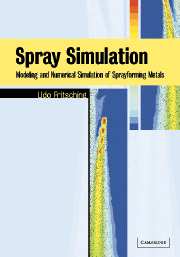7 - An integral modelling approach
Published online by Cambridge University Press: 10 August 2009
Summary
Coupling of several mechanisms into an integrated model for the spray forming process is the final aim of simulation. Such an integral spray forming model has been investigated, for example, by Bergmann (2000), Minisandram et al. (2000) (which has already been introduced in Section 6.3) and Pedersen (2003).
Connection between those submodels aforementioned has been performed, for transient temperature material behaviour, from melt superheating in the tundish to room temperature in the preform via cooling and solidification, in a three-stage approach in Bergmann (2000). Tundish melt flow and a thermal model are accounted for in the first stage. The local separation method is employed in the second stage to determine temperature-averaged properties of the spray and solid fractions in the particle mass at the centre-line of the spray. The temporal behaviour of a melt element is derived in terms of the averaged mean residence time of the particle mass. By combination of these data with calculated temporal cooling and solidification distributions of a fixed volume element inside the deposit, one yields the mean thermal history of the material at a specified location in the deposit.
The transient thermal and solidification distributions are shown in Figures 7.1 and 7.2. Results are illustrated separately for the three different modelling areas (with different time scales) for: (a) melt flow in the tundish, (b) particle cooling in the spray, (c) growth and cooling of the deposit. The process conditions used are for a steel spray forming of a Gaussian-shaped deposit (see Table 6.5).
Information
- Type
- Chapter
- Information
- Spray SimulationModeling and Numerical Simulation of Sprayforming metals, pp. 233 - 242Publisher: Cambridge University PressPrint publication year: 2004
